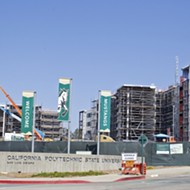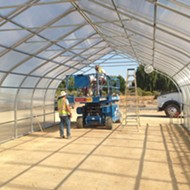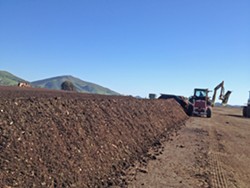From the ground up
Where you put your trash is an important step toward making Cal Poly a zero-waste campus
By Erica Hudson[{
"name": "Ad - Medium Rectangle CC01 - 300x250",
"id": "AdMediumRectangleCC01300x250",
"class": "inlineCenter",
"insertPoint": "8",
"component": "2963441",
"requiredCountToDisplay": "12"
},{
"name": "Ad - Medium Rectangle LC01 - 300x250",
"id": "AdMediumRectangleCC01300x250",
"class": "inlineCenter",
"insertPoint": "18",
"component": "2963441",
"requiredCountToDisplay": "22"
},{
"name": "Ad - Medium Rectangle LC09 - 300x250",
"id": "AdMediumRectangleLC09300x250",
"class": "inlineCenter",
"insertPoint": "28",
"component": "3252660",
"requiredCountToDisplay": "32"
}]
As Cal Poly pushes for a zero-waste future, the hardest part for the university is controlling the everyday stuff: the stuff that students, teachers, and faculty touch on a daily basis that might end up in the trash when it shouldn't.
There are many sets of trash, recycling, and compost bins stationed in densely populated areas around campus like the University Union, Kennedy Library, and the dining halls. But some students have questioned whether or not the compost actually makes it to a proper facility or if it ended up in a landfill.
"We hear these rumors of, 'They're collecting compost and sending it to a landfill,' and in some cases that's true, especially with events. In events, we see really high contamination rates," said Kylee Singh, sustainability coordinator for Cal Poly.
In areas where the composting is more controlled, like the dining kitchens, food scraps are composted. More than 100 individual composting bins were distributed to apartments in Poly Canyon Village and Cerro Vista this February. At events, there is a higher volume of people throwing materials that could be composted or recycled in the trash and vice versa, but no one is there to go through the trash to separate out all the components at the end of the day.
Santa Maria-based company Engle & Grey collects compost from food facilities on campus. The company told Cal Poly that the contamination rates from the bins "was too high for them to take," according to Singh. In separating out the bins, they found high levels of trash mixed in with the compost. The highest rate of contamination that Engle & Grey will accept is 2 percent.
During the last school year, each large compost bin got a laminated green note stating that the Zero Waste Collaborative on campus was notified that the regional composter "will no longer be able to collect any items other than food scraps." They no longer were able to compost biodegradable utensils, and were "actively exploring all options to reinstate full composting services."
In the past five years, the recycling rates on campus have decreased, and trash audits are often filled with recyclable papers, plastics, and metals. Singh said that in order for students to get better with composting, they'll have to start by learning what materials go in each bin.
"It's a really challenging piece of managing how people interact with their waste, and you only get a few seconds to convince someone one way or another," Singh said.
Organic matters
Consistent with the "Learn by Doing" motto, on-site composting took off at Cal Poly in 1997 when Dr. Doug Williams turned the small operation into an enterprise project for bioresource and agricultural engineering students.
Today, Agricultural Operations Department staff and student employees oversee the composting unit. Overall, they tend to more than 6,000 acres of Cal Poly farmland and the Swanton Pacific Ranch, composed of 3,300 acres. In a year, they will process more than 10,500 cubic yards of manure, ground-up green waste, and wood chips that results in 3,500 cubic yards of finished compost.
"The composting operation helped us create a product that's a benefit to our farming operation on campus; it also allows us to market and sell up to 1,000 yards of composting regularly," said Kevin Piper, director of Cal Poly agricultural operations.
The compost produced by agricultural operations is separate from the food waste compost monitored by the Zero Waste Collaborative. It is a manure-based soil additive and is used primarily by landscaping services and in the organic farm.
To produce large volumes of compost, the department uses windrow composting methods, where organic matter is piled into long rows and mixed with a rusty red turner that hangs over them, redistributing everything to maintain an even temperature.
The mix is turned five times within a 15-day period. A temperature of 130 degrees Farhenheit or higher needs to be maintained for the duration to kill off any harmful bacteria or viruses.
"We have to be really cognizant of the fact that when we're composting, we're managing that process and managing the moisture content," Piper said.
The finished product is sold in 8 pound bags at the plant shop, and bulk orders are available by request. Cal Poly compost is certified organic by the CDFA's Organic Input Materials Program, registering fertilizer material to be used for crop and food production. Δ
Reach contributor Erica Hudson through the editor at [email protected].
Speaking of Student Guide 2017
-

Packed in: Housing at Cal Poly is getting pretty tight
Sep 14, 2017 -

Foothill's food show
Sep 14, 2017 -

Planting seeds
Sep 14, 2017 - More »
Latest in News
Readers also liked…
-

Coast Unified teachers upset over new position's salary and qualifications
Oct 20, 2022 -

SLO police identify alleged driver who hit and killed couple
Dec 22, 2022 -

When the levee breaks: Oceano residents, county officials walk a tightrope of regulations to manage Arroyo Grande Creek, which some say led to the levee's failure in January
May 18, 2023









